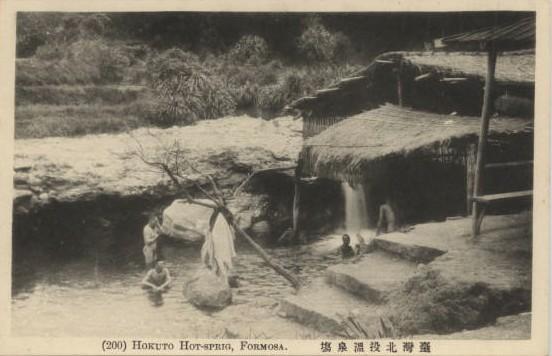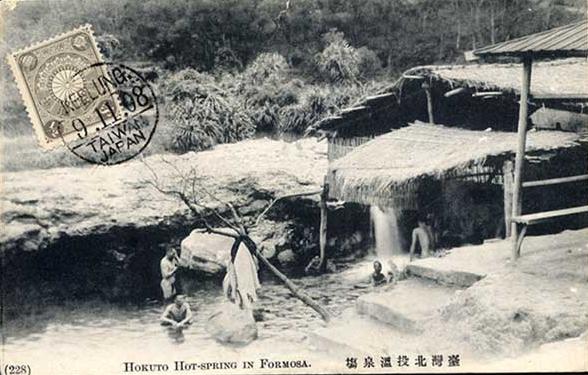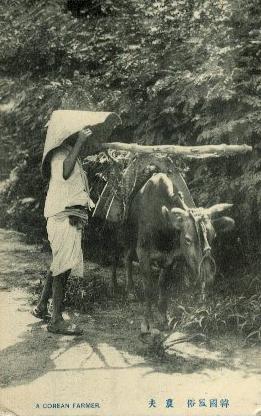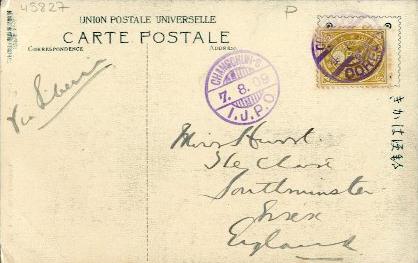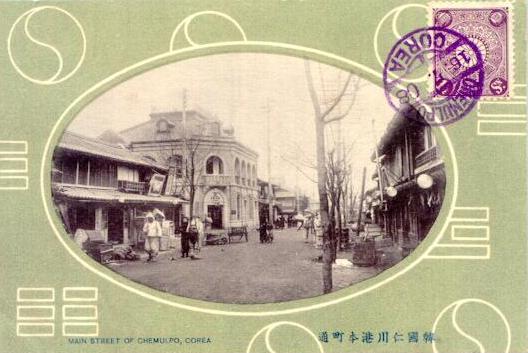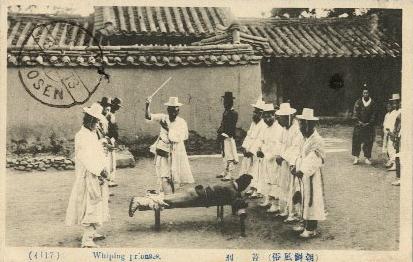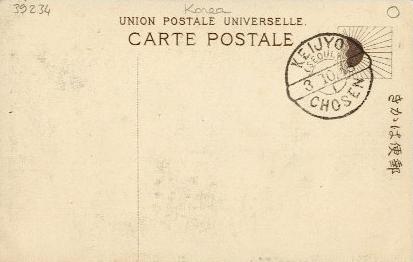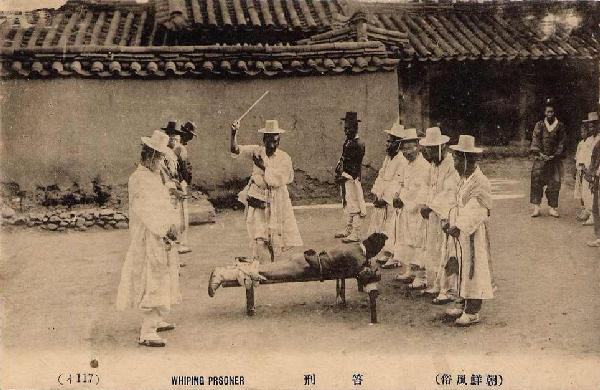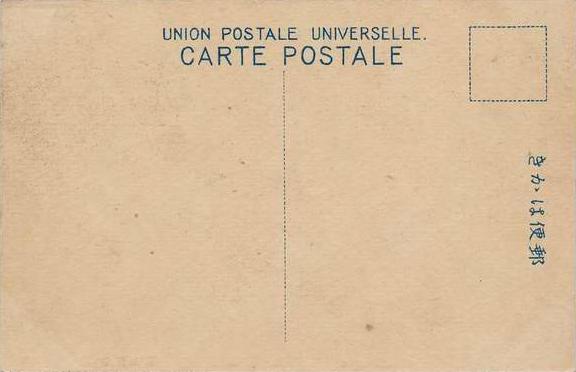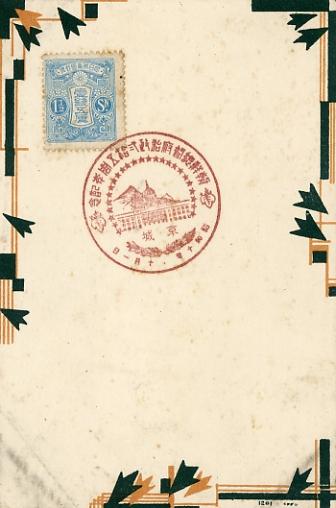The empire of postcards
"Customs" of places and peoples
By William Wetherall
First posted 1 December 2009
Last updated 15 December 2009
Photo postcards Taiwan | Karafuto | Korea as Chosen | Manchoukuo
Postcards
Forthcoming.
The message side of most such cards show the following lines, in addition sometimes to photo captions, printing data, and instructions to users.
UNION POSTALE UNIVERSELLE
CARTE POSTALEXÖͪ«
Postcards picturing Taiwan and Taiwanese
Forthcoming
1908 Taiwan Keelung postcardThe postcard to the right, copped and cropped from World-Covers.Com (/cover-33715, /pics/v5545.jpg), bears a frank from Keelung, a port town at the northern tip of Taiwan. Keelung (î² WC Chilung, YP Jilong), then Taiwan's principal port, was close to Taipei (SJ Hokuhei), a city which today includes the Peit'ou (PY Beitou) district and its spas, known in Sino-Japanese as Hokutō. The message side of the received image of this card bears no writing, and is unstamped and unfranked, suggesting that the card was not actually sent anywhere -- though World-Covers.com says it was sent to France.
Hokutō was the Sino-Japanese for Mandarin Peit'ou (PY Beitou). Another edition of the same card shows "(200) Taito Hot-sprig [sic], Formosa." The (228) card is apparently a later corrected version of this card. (Item 376 in The Michael Lewis Taiwan Image Collection, a large collection of picture postcards from Taiwan during the period that it was part of Japan, digitalized by Lafayette College Libraries, Lafayette College, Easton, Pennsylvania, in the United States.) |
Postcards picturing Karafuto and Karafutoans
Forthcoming
Forthcoming.
Postcards picturing Korea and Koreans
Numerous photo postcards were produced for use by people traveling in, or to and from, Korea. There is a huge and active trade in such postcards in Japan, both at shops that feature vintage printed matter, and on Internet auction sites.
Many of the photo postcards representing Korea and Koreans are bilingual. Captions are usually shown in Japanese. The spellings in English representations of place names written in Chinese characters, especially during the period that Korea was part of Japan, are usually romanized according to Sino-Japanese rather than Sino-Korean pronunciations.
Keijo, Chosen
Koreans playing chess, Chosen
However, "Korea" and "Corea" are also found on some postcards which seem to have been printed and used during the period that Korea was Chosen. Such usage seems to reflect habits of representation in English, intended for tourists or recipients who might not be able to read the Chinese characters, and might not be familiar with SJ "Chōsen" much less SK "Chosŏn".
1909 Corean farmer postcard with Corea and IJPO franksThe card shown here was mailed to England from the Empire of Korea on 4 August 1909. Three days later it passed through the Imperial Japanese Post Office at Changchun (·t) in Manchuria. Its "Corea" frank therefore corresponds to the name of the country as stated in the caption, namely, "Kankoku" -- which would not become "Chōsen" until 29 August 1910, a year later.
The dates on the "Corea" and "IJPO" (Imperial Japanese Post Office) franks are respectively 4 and 7 August 1909 -- meaning that the card was in transit for three days or so between the two frankings on the first leg of its journey to England "Via Siberia". The "Via Siberia" is written in the hand of the person who addressed the card. Postcards and covers of the period commonly bear such notices, which were written to show mail sorters the intended routing of international mail. Some cards and covers show several franks indicating each jurisdictional office through which the mail passed in transit from its origin to its destination. There were no sorting machines, no electronic scanners, no bar codes, and not a lot of international standards regarding mail handling. Then as now, notwithstanding the friendliness of ties between two countries, third-party routings were essential in the absence of direct transportation routes. And notwithstanding the possibility of direct routing, hostility between neighboring countries sometimes required routing through third-party entities. During World War II, there were rules for sending and routing mail to and from Japanese POW camps in Taiwan, Osaka, and other localities within Japan, as well in Southeast Asian countries. Most such covers of mail to or from POWs show a censor stamp for at least one of the belligerent states. |
1908 Korean postcard with Chemulpo, Corea frankThis card, posted from Korea two years before it joined Japan as Chosen, bears a frank reading "Chemulpo, Corea".
"Chemulpo" was the most common romanization of the Sino-Korean reading of ϨY (제물포 Chemulp'o) or "Saimoppo" in Sino-Japanese. It was the more familiar name for the port on the west coast of the Korean peninsula that by then was also associated with Inchon (mì SK Inch'ŏn) or "Ninsen" in Sino-Japanese. There appears, though, to have been a formal distinctions between the two names at the time. Chemulpo was the site of the signing on 30 August 1882 of the so-called "Chemulpo treaty" (àZ¨Yñ SJ Saimoppo jōyaku, SK Chemulp'o choyak), following an incident in July that year in which the Korean palace and the Japanese legation at Hansŏng (¿é), or Seoul, were attacked by rebels. The Japanese delegation escaped to Chemulpo, where they were rescued by a British ship. Shortly before this incident, on 22 May 1882, Korea had signed a treaty with the United States at Gensan (³R Wŏnsan). A year later, on 26 November 1883, Korea signed a treaty with the United Kingdom of Great Britain at Hanyang (¿z), aka Hansŏng (¿é), later Keijō (é SK ), namely Seoul. |
"Whipping prisoner" postcard 1913 Keijyo (Seoul), Chosen frankHowever, Kushibo (Monster Island!) shows both sides of a picture postcard, which has no stamp or address or message, but has the same franking both where the stamp would be and on the picture, "KEIJYO / (SEOUL) / 3.10.13 / CHOSEN". Kushibo says that Keijyo is "a later alternate spelling of Keijō" but in fact a spelling based on the older romanization would be "Keijiyau" which leads to "Keijyō" and "Keijō".
The first shown card, stamped and franked but not addressed, was probably a carry-home "I was there" souvenir. Chinese script reading left to right under to picture of men administrating punishment by whipping says (©N) ÛY -- which reads "(Chōsen fūzoku) Taikei". The ÛY (taikei), however, is an error for âY (chikei), which means punishment by whipping. Beside this is English reading "Whiping [illegible]". The illegible part appears to start with "p". "Chōsen fūzoku" means "Chosen customs" and as such it classifies this very common genre of Korean souvenir postcard showing photographs of Korean life. This card shows several men whipping a man in what appears to be a formal administration of punishment. Such cards were extremely common. Another edition of the same card has been offered as "Vintage KOREA photo postcard" in the "Collectibles, Postcards, Cultures Ethnicities, Asian category" on eBay for $49.99 (December 2009). This edition shows the correct Japanese term, while the English has "WHIPING PRSONER" [sic] in uppercase. The card, unused and unfranked, has the same number (C117) [i 117] below the photo, but the box for the stamp on the message side is plain, whereas that of the Kushibo copy is of the decorative rising sun style. |
|||||||||
1935 postcard celebrating 25th anniversary of GGCThe Government-General of Chosen, like all organizations, celebrated anniversaries of its founding. The card shown here represents one form in which the GGC celebrated its 25th anniversary. A regular 1.5 sen postage stamp of the period is affixed to the card. The stamp is cancelled with a special frank celebrating the 25th anniversary of GGC's start on 1 October 1910. The date on the frank is Showa 10-10-1 -- or 1 October 1935.
Though not otherwise marked as a postcard, the card is of the same size and stock as a conventional postcard. There is no printing, writing, or other markings on the back. The card thus appears to have been intended as a souvenir. In fact, unaddressed and otherwise blank picture postcards, too, were sometimes stamped and neatly cancelled as "I was here" souvenirs. And first day covers, bearing franks which certify the place and date that the affixed stamps were officially issued, have also been sold over the counter without actually mailing. Whether cards of this design were specially printed for the occasion, or whether this card just happened to be at hand, is not clear. |
Postcards picturing Manchoukuo and Manchoukuoans
Forthcoming
